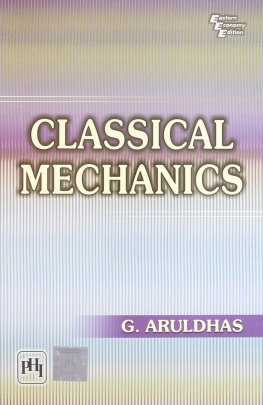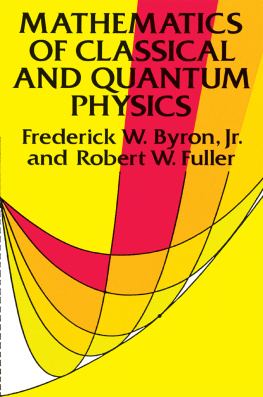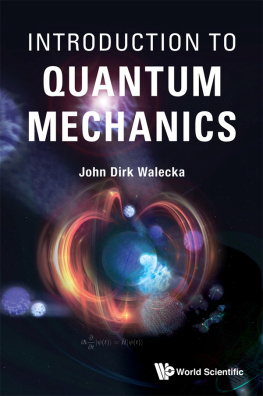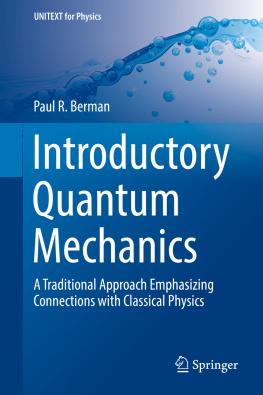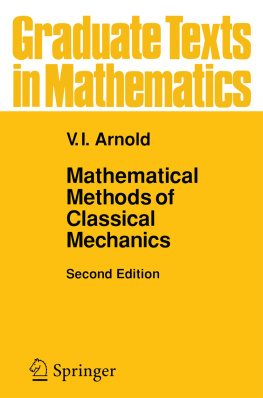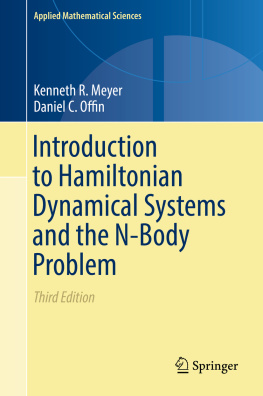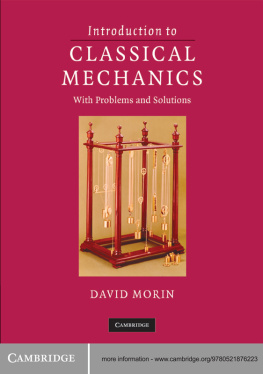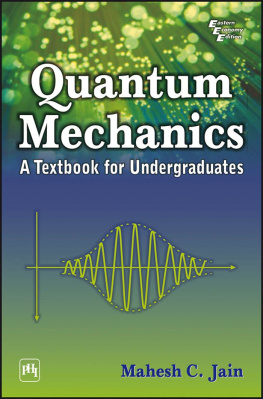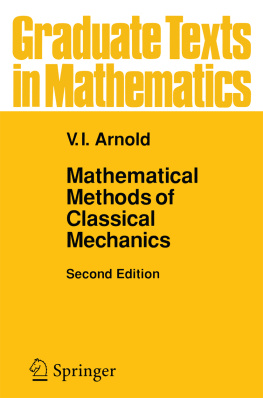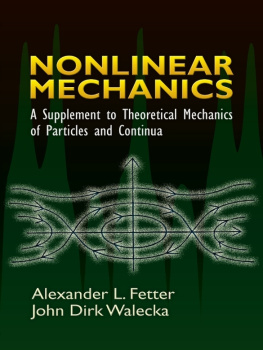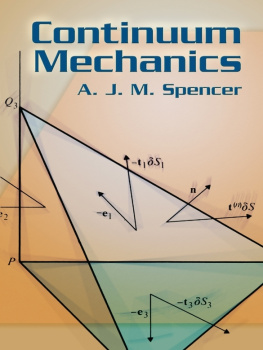Clas s ical Mechanics
G. Aruldhas
Formerly
Professor & Head of Physics & Dean Faculty of Science
University of Kerala

New Delhi-110001
2008
CLASSICAL MECHANICS
G. Aruldhas
2008 by PHI Learning Private Limited, New Delhi. All rights reserved. No part of this book may be reproduced in any form, by mimeograph or any other means, without permission in writing from the publisher.
ISBN-978-81-203-3331-4
The export rights of this book are vested solely with the publisher.
Published by Asoke K. Ghosh, PHI Learning Private Limited, M-97, Connaught Circus, New Delhi-110001 and Printed by Jay Print Pack Private Limited, New Delhi-110015.
To
Myrtle and our children
Vinod & Anitha, Manoj & Bini, Ann & Suresh
Contents
Preface xi
1.1 Frames of Reference
Cartesian Co-ordinates ( x , y , z )
Plane Polar Co-ordinates ( r , q )
Cylindrical Co-ordinates ( r , f , z )
Spherical Polar Co-ordinates ( r , q , f )
1.2 Newtons Laws of Motion
Newtons First Law of Motion
Newtons Second Law of Motion
Newtons Third Law of Motion
1.3 Inertial and Non-inertial Frames
1.4 Mechanics of a Particle
Conservation of Linear Momentum
Angular Momentum and Torque
Conservation of Angular Momentum
Work Done by a Force
Conservative Force
Conservation of Energy
1.5 Motion under a Constant Force
1.6 Motion under a Time-dependent Force
1.7 Reflection of Radiowaves from the Ionosphere
1.8 Motion under a Velocity Dependent Force
1.9 Motion of Charged Particles in Magnetic Fields
Worked Examples
Review Questions
Problems
2.1 Centre of Mass
2.2 Conservation of Linear Momentum
2.3 Angular Momentum
2.4 Conservation of Angular Momentum
2.5 Kinetic Energy for a System of Particles
2.6 Energy Conservation of a System of Particles
2.7 Time Varying Mass SystemsRockets
Worked Examples
Review Questions
Problems
3.1 Constraints
Holonomic Constraints
Non-holonomic Constraints
Scleronomous and Rheonomous Constraints
3.2 Generalized Co-ordinates
Degrees of Freedom
Generalized Co-ordinates
Configuration Space
3.3 Principle of Virtual Work
3.4 DAlemberts Principle
3.5 Lagranges Equations
3.6 Kinetic Energy in Generalized Co-ordinates
3.7 Generalized Momentum
3.8 First Integrals of Motion and Cyclic Co-ordinates
Cyclic Co-ordinates
3.9 Conservation Laws and Symmetry Properties
Homogeneity of Space and Conservation of Linear Momentum
Isotropy of Space and Conservation of Angular Momentum
Homogeneity of Time and Conservation of Energy
3.10 Velocity-dependent Potential
3.11 Dissipative Force
3.12 Newtonian and Lagrangian Formalisms
Worked Examples
Review Questions
Problems
4.1 Hamiltons Principle
4.2 Deduction of Hamiltons Principle
4.3 Lagranges Equation from Hamiltons Principle
4.4 Hamiltons Principle for Non-holonomic Systems
Worked Examples
Review Questions
Problems
5.1 Reduction to One-body Problem
5.2 General Properties of Central Force Motion
Angular Momentum
Law of Equal Areas
5.3 Effective Potential
5.4 Classification of Orbits
5.5 Motion in a Central Force FieldGeneral Solution
Energy Method
Lagrangian Analysis
5.6 Inverse Square Law Force
5.7 Keplers Laws
5.8 Law of Gravitation from Keplers Laws
5.9 Satellite Parameters
5.10 Communication Satellites
5.11 Orbital Transfers
5.12 Scattering in a Central Force Field
5.13 Scattering Problem in Laboratory Co-ordinates
Worked Examples
Review Questions
Problems
6.1 The Hamiltonian of a System
6.2 Hamiltons Equations of Motion
6.3 Hamiltons Equations from Variational Principle
6.4 Integrals of Hamiltons Equations
Energy Integral
Integrals Associated with Cyclic Co-ordinates
6.5 Canonical Transformations
6.6 Poisson Brackets
Fundamental Poisson Brackets
Fundamental Properties of Poisson Brackets
Equations of Motion in Poisson Bracket Form
6.7 Poisson Bracket and Integrals of Motion
6.8 The Canonical Invariance of Poisson Bracket
6.9 Lagrange Brackets
6.10 D -Variation
6.11 The Principle of Least Action
Different Forms of Least Action Principle
6.12 Poisson Brackets and Quantum Mechanics
Worked Examples
Review Questions
Problems
7.1 HamiltonJacobi Equation
Physical Significance of S
7.2 Hamiltons Characteristic Function
7.3 Harmonic Oscillator in The H- j Method
7.4 Separation of Variables in The H- j Equation
7.5 Central Force Problem in Plane Polar Co-ordinates
7.6 Action-Angle Variables
7.7 Harmonic Oscillator in Action-Angle Variables
7.8 Kepler Problem in Action-Angle Variables
7.9 Road to Quantization
Worked Examples
Review Questions
Problems
8.1 Introduction
8.2 Angular Momentum
8.3 Kinetic Energy
8.4 Inertia Tensor
8.5 Principal Axes
8.6 Eulers Angles
8.7 Infinitesimal Rotations
8.8 Rate of Change of a Vector
8.9 Coriolis Force
8.10 Eulers Equations of Motion
8.11 Force-free Motion of a Symmetrical Top
8.12 Heavy Symmetric Top with One Point Fixed
Worked Examples
Review Questions
Problems
9.1 Equilibrium and Potential Energy
9.2 Theory of Small Oscillations
9.3 Normal Modes
9.4 Two Coupled Pendula
Resonant Frequencies
Normal Modes
9.5 Longitudinal Vibrations of CO Molecule
Normal Frequencies
Normal Modes
Normal Co-ordinates
Worked Examples
Review Questions
Problems
10.1 Galilean Transformation
10.2 Electromagnetism and Galilean Transformation
10.3 MichelsonMorley Experiment
The Interferometer
The Experiment
10.4 The Postulates of Special Theory of Relativity
10.5 Lorentz Transformation
10.6 Velocity Transformation
10.7 Length Contraction
10.8 Time Dilation
10.9 Simultaneity
10.10 Mass in Relativity
10.11 Mass and Energy
10.12 Relativistic Lagrangian of a Particle
10.13 Relativistic Hamiltonian of a Particle
10.14 Space-Time Diagram
10.15 Geometrical Interpretation of Lorentz Transformation
10.16 Principle of Covariance
10.17 Four-Vectors in Mechanics
Position Four-Vector
Four-Velocity
Momentum Four-Vector
Four-Force
Four-Acceleration
10.18 Charge Current Four-Vector
10.19 Invariance of Maxwells Equations
Maxwells Equations
Vector and Scalar Potentials
Gauge Transformations
Four-Vector Potential
10.20 Electromagnetic Field Tensor
10.21 General Theory of Relativity
Principle of Equivalence
Bending of Light in a Gravitational Field
Precession of the Perihelion of Planetary Orbits
Space Curvature
Gravitational Red Shift
Worked Examples
Review Questions
Problems
11.1 Linear and Nonlinear Systems
11.2 Integration of Linear Equation: Quadrature Method
11.3 Integration of Nonlinear Second Order Equation
11.4 The Pendulum Equation
11.5 Phase Plane Analysis of Dynamical Systems
Phase Curve of Simple Harmonic Oscillator
Phase Curve of Damped Oscillator
11.6 Phase Portrait of the Pendulum
11.7 Matching of Phase Curve with Potential V ( x )
Next page
